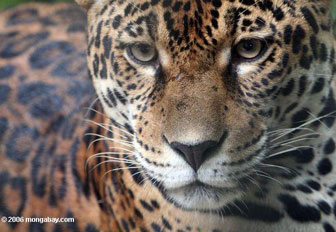Border fence may drive jaguar to extinction in the U.S.
Border fence may drive largest American cat to extinction
mongabay.com
January 22, 2008
|
|
The Bush Administration’s decision to not prepare a recovery plan for the endangered jaguar in its native habitat in Arizona and New Mexico may spell the end for the big cat in the United States, says an environmental group.
The Center for Biological Diversity says the U.S. Fish and Wildlife Service’s decision seeks to circumvent the Endangered Species Act from plans to build thousands of miles of wall on the U.S.-Mexico border without environmental review.
“The wall will short-circuit current efforts by jaguars to recolonize the United States,” said the group in a statement. The jaguar once ranged from Monterey Bay, California, to the Appalachian Mountains, and currently occurs in southern Arizona and New Mexico where it is listed as an endangered species.
 Photo by R. Butler |
“This is a jaguar death sentence,” said Michael Robinson of the Center for Biological Diversity. “The decision violates the Endangered Species Act, U.S. Fish and Wildlife Service policy, and common sense. The jaguar is clearly a U.S. species.”
Dr. Joe Cook, professor of biology at the University of New Mexico and board member of the American Society of Mammalogists, says that while the U.S. has historically taken a leadership role in international conservation, the latest decision reflects a major shift in conservation policy under the Bush Administration.
“Unfortunately, this decision is consistent with an abdication of leadership in the field of conservation of wildlife over the past seven years,” said Cook. “If the U.S. cannot make a genuine effort to conserve the jaguar within our borders than how can we ask developing countries to step up to the plate to support this vital part of their fauna?”
Camera traps have photographed four jaguars in southern Arizona and New Mexico since 1996. They are believed to migrate between Mexico and the United States.
The 700-mile (1,125km) fence along the U.S.-Mexico border is expected to cost more than $2 billion.